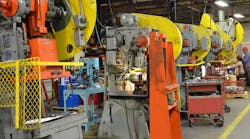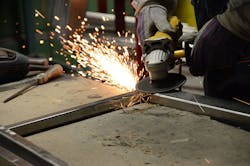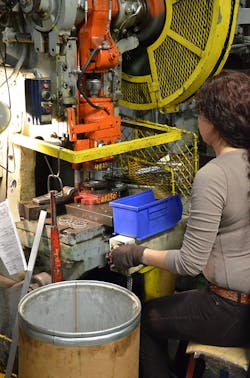When original equipment manufacturers (OEMs) outsource component parts manufacturing, the type of fabrication, stamping, or machining technique utilized is often a major factor in the final per-piece cost. However, the initial volumes required may also dictate the metalworking technique or process selected, particularly for new products just beginning to find a market. While certain complex metal parts can only be machined, thinner gauge parts and enclosures are typically stamped using hard tooling or fabricated using lasers, turret presses, or press brakes.
For start-ups or smaller companies with more modest production requirements, however, avoiding the high upfront costs of hard tooling can be appealing. As a result, fabrication alternatives that do not require that investment—even if the cost per piece is higher—are the better initial choice. But what happens when demand increases and an OEM needs to scale up production?
When this is the case, determining the ideal time to transition to a more economical alternative can be challenging. In some cases, it can even involve the difficult decision to move from a trusted supplier. After all, most sheet metal fabricators do not also offer stamping, and vice versa.
This is where more sophisticated “one-stop” metal parts manufacturers can deliver a significant advantage. By offering the full gamut of sheet metal fabrication, stamping, and machining options under one roof, these larger operations are in a much better position to scale with the customer as demand increases.
This includes facilitating the transition to hard tooling, mixing, and matching metalworking techniques for multi-component assemblies, along with incorporating hybrid and secondary tooling approaches to further reduce costs.
The Progression of Options
By offering the full gamut of sheet metal fabrication options under one roof, larger operations are in a much better position to scale with the customer as demand increases.
DureX was founded in 1946. The metal parts manufacturer provides metal stamping, sheet metal fabrication, and CNC machining. According to Bob Denholtz, the company’s president, deciding on the best technique to manufacture a part involves a careful analysis of the production volume versus the cost of the hard tooling.
“With a sheet metal part that costs $10, it may cost $6 for stamping, but the OEM may have to spend $30-40,000 in tooling,” says Denholtz. “So, for that $4 saving, they need to make sure they have 10-20,000 pieces so they can pay off the tooling quickly.”
According to Denholtz, a one-stop-shop can work with a customer by offering a full progression of options based on what he calls “the return on investment (ROI) threshold.” For example, for a startup that needs 500 units per month, it may not make sense to spend the money for stamping so the part can be fabricated.
As the program matures and the OEM goes from 500 to 5,000 units per month, the customer can move from fabrication to hard tooling in a smooth transition with the same supplier. In one real-world example, Denholtz says a customer was spending $18 for a power supply chassis with a $4 cover. As volume requirements increased, DureX suggested it was time to move to hard tooling. This reduced the overall cost from $22 to $14.
“The customer is saving $8 a unit and now they are up to over 3,000 units a month,” he explains. “The tooling cost $80,000, so at $24,000 in savings each month it took 3.5 months to get the money back.”
Had it not been cost-effective to use hard tooling for the box, it many have been for the cover because it is a cheaper tool. In that case, the customer could continue to receive a set of parts from the same supplier. A hybrid approach can even be used. “I may fabricate a part on our turret press or use laser cutting, and then use a hard tool to form it into a box,” says Denholtz. Tools can also be staged to create a blank before a secondary press is used to form it into a box with another hard tool. Finally, if it is determined that it is worth the cost, a full-blown progressive die can be purchased that will form the entire box completely with very little labor.
Air Conditioning Parts
Simon-Aire Inc. manufactures Packaged Terminal Air Conditioners, a type of self-contained HVAC system commonly found in hotels, senior housing facilities, hospitals, dormitories, and apartment buildings. The company also offers parts and accessories, including replacement chassis, hydronic heat assemblies, louvers, wall sleeves, room enclosures, and control components. For these products, Simon-Aire requires a variety of metal parts and components from DureX.
DureX, Inc. operates a 120,000-sq.-ft. facility that provides metal stamping, sheet metal, fabrication and CNC machining.
Simon-Aire pursed a project with DureX that would help them reduce the amount of warehouse space required for a volume of large, bulky products in inventory. “Many of our sheet metal components are basically like a box, so they take up a lot of dead air space,” explains Michael Milazzo, CEO of Simon-Aire. “If you have hundreds of them, you’re paying a lot of money to store them.”
Durex helped developed a “knockdown” box that could be stored flat until final finishing and assembly. This would allow 50 or 60 components to be stored in the same space that normally fit about 12. “That is going to make a big difference, because that saves a lot of space, which in a warehouse translates into money,” says Milazzo, adding that it also provides him with a competitive edge over his much larger competitors.
He also notes that it’s important to have a good, collaborative relationship with the metal parts supplier. This includes working from the prototype phase through product development.
By offering a variety of metalworking and fabricating options, a one-stop parts manufacturer can also be used by larger companies that deal with hundreds—even thousands—of vendors to consolidate its vendor base.
“By dealing with one vendor instead of many, that means one purchase order, one visit to the vendor, one quality survey, one check to write,” says Denholtz. “It can take a lot of managing if you have to 10, 20, or 30 vendors.”
For more information on metal manufacturing practices, visit DureX.



